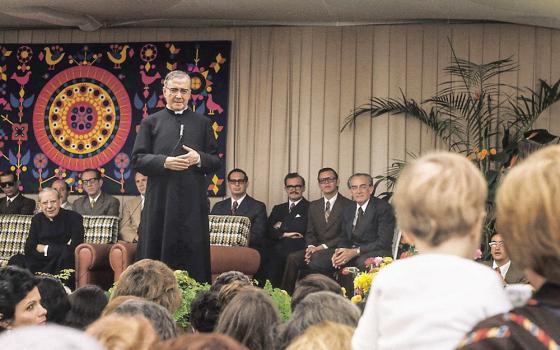“The Spirit of the Lord is upon me, because he has anointed me to preach good news to the poor. He has sent me to proclaim release to the captives and recovering of sight to the blind, to set at liberty those who are oppressed, to proclaim the acceptable year of the Lord.” Luke 4:18-19.
This is how Jesus Christ, quoting the Prophet Isaiah, announced his ministry at a synagogue in Nazareth. The ministry of the Church is only Catholic insofar as it grows forth from this announcement. We minister precisely because we are anointed by the Spirit: without that, as Pope Francis recently said, we risk becoming just another NGO. They do good work but they are non Christian ministries. And, the content of the ministry is clear: good news to the poor, release for captives, recovery of sight to the blind, liberty to the oppressed.
Here in the United States where, despite our enormous wealth, there remain millions of poor fellow Americans, people who are not only trapped in actual poverty but in conditions in which the amelioration of poverty faces enormous obstacles: Under-educated students in failing schools, children born to single moms who are already poor, crime that prevents children from exploring their neighborhood let alone the world beyond, a lack of access to basic health care or affordable housing.
Since 1970, the Catholic Campaign for Human Development has awarded grants to organizations the fight the root causes of poverty. The efforts they make are usually quite pedestrian: They helped the Immokalee Farm Workers in Florida in their fight to increase their wages. In a Midwestern city, the helped get a bus line extended an additional mile to a regular supermarket so that residents did not face the choice of walking an additional mile in inclement weather or going to the corner store where items are often twice what they are in a supermarket. The CCHD does not open soup kitchens, although there is nothing wrong with soup kitchens. Instead, CCHD works to empower the poor to take greater control over their own lives, to overcome the barriers that keep them in poverty.
You would think that such a mission would appeal to conservatives. The CCHD is precisely the kind of social justice effort that embodies subsidiarity, empowering local communities, not applying a top-down, government-run program. By building up communities, it helps give unwed mothers access to the kind of support they would need if they choose to keep a child. By building up communities, it helps ensure that people are treated not only with an abstract dignity, but that their human dignity is enfleshed in a more livable social environment. By building up communities, CCHD helps the families in a given community argue for better schools, higher wages, and safer streets. Why is this seen as a radical leftie agenda?
My colleague Tom Roberts posted the news story about a report released by the group Faith in Public Life this week that details the attacks to which CCHD has been subject in recent years. Here is a link to Tom’s article and here is a link to the report itself. Reading the report, and all the good things CCHD does, I do not see how anyone can fail to be proud about the CCHD and its carrying on the ministry of Jesus.
But, as the report notes, several conservative groups, led by the American Life League, have tried to get CCHD killed. They fret that in working with other groups, many of which are not Catholic, on behalf of the poor, we are somehow tainting our Catholic identity. Some of these groups belong to other coalitions that may even support same sex marriage. It doesn’t matter to the American Life League that the groups CCHD funds do not themselves advocate for same sex marriage, or that a given non-Catholic coalition that is primarily focused on, say, helping immigrants, may have joined with others to support an issue, even though such support consists solely in signing a petition. No, the American Life League wants the smaller, purer Church. Hell, there is not really room for Cardinal Sean O’Malley in the American Life League’s Church after he “spit on Christ” by presiding at the funeral of Sen. Edward Kennedy.
If the American Life League wants to be kooky, and they have trouble being anything but, it is no skin off my nose. But, why does anyone listen to them? And, to be sure, there are bishops who have suspended CCHD collections in their diocese. There are other bishops who have hamstrung CCHD by enacting grant-making rules that virtually keep the Church from working effectively with anyone who is not already canonized. This is insane. As the Faith in Public Life report indicates, there is a McCarthyism here, and I would add a Jansenism. The combination is supremely ugly.
The last couple of years, I have attended the CCHD reception at the annual bishops’ conference meeting. CCHD supporters are hardly fire-breathing lefties. Bishop Kevin Farrell of Dallas gave a stirring cal for all dioceses to support CCHD’s work two years ago. Cardinal Dolan has been at the reception both of the last couple of years. Bishop David O’Connell was there last year. This is not a Marxist cabal.
The Holy Father has, on multiple occasions now, indicated that a Church which stays within itself becomes a sick Church. The Holy Father, again repeatedly, calls the Church to go out to the margins, to the peripheries, to be among the poor. That is exactly what CCHD does. It does not swoop in an tell the poor to do this or do that; instead, CCHD listens to the poor and asks how it can help. Need an extended bus line to the market, here is how we can organize to achieve that. Need another penny a bushel for tomatoes picked in the heat of the Florida fields? Here is how we can help. As I say, their work is pedestrian, but those feet are walking in the footsteps of Jesus. It is clear that the American Life League has no shame, but the bishops who oppose CCHD should be ashamed of themselves.




